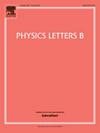伪规范变换的动力学约束
IF 4.3
2区 物理与天体物理
Q1 ASTRONOMY & ASTROPHYSICS
引用次数: 0
摘要
在重离子碰撞的流体力学模型中讨论了经典的伪规范变换。将伪规范变换分解为洛伦兹不变张量,可以更好地解释其物理结果。对于连接两个对称能量-动量张量的伪规范变换,我们发现超势Φλμν必须遵循∂λΦλμν=0的守恒定律。这个方程,下面称为STS条件,代表了一个约束,对于由基本流体动力学变量(如温度、重子化学势和流体动力学流量)构成的张量几乎不可能满足。然而,在升压不变流的特殊情况下,STS条件自动满足,并且允许由单个标量场定义的非平凡剩余伪规范变换。在这种情况下,体积和剪切粘度系数成为伪规范依赖;然而,它们在运动方程中出现的特定线性组合仍然是伪规范不变的。这一发现为伪规范变换和伪规范不变性的作用提供了新的见解。本文章由计算机程序翻译,如有差异,请以英文原文为准。
Dynamical constraints on pseudo-gauge transformations
Classical pseudo-gauge transformations are discussed in the context of hydrodynamic models of heavy-ion collisions. A decomposition of the pseudo-gauge transformation into Lorentz-invariant tensors is made, which allows for better interpretation of its physical consequences. For pseudo-gauge transformations connecting two symmetric energy-momentum tensors, we find that the super-potential must obey a conservation law of the form . This equation, referred to below as the STS condition, represents a constraint that is hardly possible to be satisfied for tensors constructed out of the basic hydrodynamic variables such as temperature, baryon chemical potential, and the hydrodynamic flow. However, in a special case of the boost-invariant flow, the STS condition is automatically fulfilled and a non-trivial residual pseudo-gauge transformation defined by a single scalar field is allowed. In this case the bulk and shear viscosity coefficients become pseudo-gauge dependent; however, their specific linear combination appearing in the equations of motion remains pseudo-gauge invariant. This finding provides new insights into the role of pseudo-gauge transformations and pseudo-gauge invariance.
求助全文
通过发布文献求助,成功后即可免费获取论文全文。
去求助
来源期刊

Physics Letters B
物理-物理:综合
CiteScore
9.10
自引率
6.80%
发文量
647
审稿时长
3 months
期刊介绍:
Physics Letters B ensures the rapid publication of important new results in particle physics, nuclear physics and cosmology. Specialized editors are responsible for contributions in experimental nuclear physics, theoretical nuclear physics, experimental high-energy physics, theoretical high-energy physics, and astrophysics.
 求助内容:
求助内容: 应助结果提醒方式:
应助结果提醒方式:


